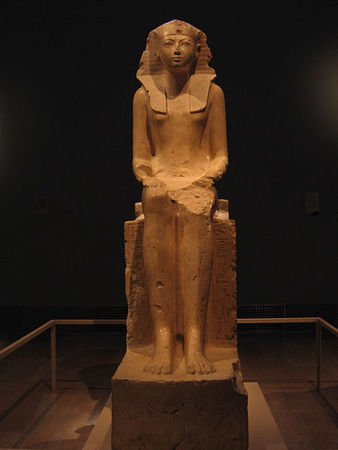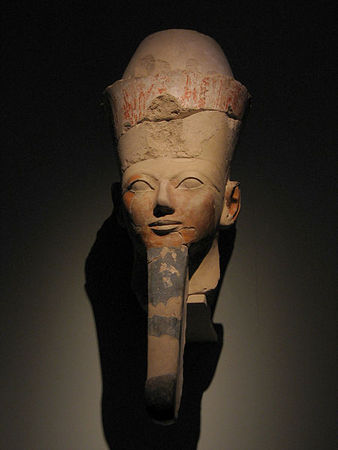20 août 2011
Experts from German University Say Toxic Substance in Egyptian Queen Hatshepsut Flask
A scientist at the university of Bonn displays a flask in Bonn, Germany, Friday, Aug. 19, 2011. The university says researchers have discovered a carcinogenic substance in the flask believed to have belonged to Queen Hatshepsut, who ruled Egypt 3,500 years ago. The scientists spent two years researching the dried-out contents of the flask, which is part of its Egyptian Museum's collection and bears an inscription saying it belonged to Hatshepshut. AP Photo/dapd, Sascha Schuermann
BERLIN (AP).- A German university said Friday that researchers have discovered a carcinogenic substance in a flask of lotion believed to have belonged to Queen Hatshepsut, who ruled Egypt 3,500 years ago — raising a possibility she may have accidentally poisoned herself.
The University of Bonn said it spent two years researching the dried-out contents of the flask, which is part of its Egyptian Museum's collection and bears an inscription saying it belonged to Hatshepshut.
It said the flask contains what appears to have been a lotion or medicine used to tackle skin disorders such as eczema.
The contents included palm and nutmeg oil, along with fatty acids of the kind that can relieve such disorders. There are known to have been cases of skin diseases in Hatshepsut's family, the university said.
Researchers also found benzopyrene, an aromatic and highly carcinogenic hydrocarbon.
"If one imagines that the queen had a chronic skin disease and the ointment gave her short-term relief, then she may have exposed herself to a major risk over the course of a few years," Helmut Wiedenfeld of the university's pharmaceutical institute said in a statement.
Egyptian officials have said that the mummy of Hatshepsut suggests the woman was obese, probably suffered from diabetes, had liver cancer and died in her 50s.
Hatshepsut is believed to have stolen the throne from her young stepson, Thutmose III, who scratched her name from stone records in revenge after her death.
The University of Bonn said it spent two years researching the dried-out contents of the flask, which is part of its Egyptian Museum's collection and bears an inscription saying it belonged to Hatshepshut.
It said the flask contains what appears to have been a lotion or medicine used to tackle skin disorders such as eczema.
The contents included palm and nutmeg oil, along with fatty acids of the kind that can relieve such disorders. There are known to have been cases of skin diseases in Hatshepsut's family, the university said.
Researchers also found benzopyrene, an aromatic and highly carcinogenic hydrocarbon.
"If one imagines that the queen had a chronic skin disease and the ointment gave her short-term relief, then she may have exposed herself to a major risk over the course of a few years," Helmut Wiedenfeld of the university's pharmaceutical institute said in a statement.
Egyptian officials have said that the mummy of Hatshepsut suggests the woman was obese, probably suffered from diabetes, had liver cancer and died in her 50s.
Hatshepsut is believed to have stolen the throne from her young stepson, Thutmose III, who scratched her name from stone records in revenge after her death.
Her two-decade rule in the 15th century B.C. was the longest among ancient Egyptian queens, at a time of the New Kingdom's "golden age." Copyright 2011 The Associated Press.
Detail of Hatshepsut, Eighteenth dynasty of Egypt, c. 1473-1458 B.C. Indurated limestone sculpture at the Metropolitan Museum of Art, New York City. (source www.commons.wikimedia.org)
Hatshepsut, Eighteenth dynasty of Egypt, c. 1473-1458 B.C. Indurated limestone sculpture at the Metropolitan Museum of Art, New York City. (source www.commons.wikimedia.org)
Fragmentary statue of Hatshepsut. Made of quartz diorite, dating to the 18th dynasty, circa 1498-1483 B.C. Now residing in the Museum of Fine Arts, Boston. (source www.commons.wikimedia.org)
Osiride head of Hatshepsut, Eighteenth dynasty of Egypt, c. 1503-1482 B.C., found at Deir el-Bahri, Thebes. Painted limestone sculpture at the Metropolitan Museum of Art, New York City. (source www.commons.wikimedia.org)
Photo of a bust of the pharoah Hatshepsut, taken at the New Museum, Berlin (part of the Ägyptisches Museum Berlin collection). (source www.commons.wikimedia.org)
Publicité
Publicité
Commentaires

/https%3A%2F%2Fprofilepics.canalblog.com%2Fprofilepics%2F1%2F0%2F100183.jpg)
/https%3A%2F%2Fstorage.canalblog.com%2F03%2F02%2F119589%2F96711876_o.jpg)
/https%3A%2F%2Fstorage.canalblog.com%2F11%2F31%2F119589%2F94773502_o.jpg)
/https%3A%2F%2Fstorage.canalblog.com%2F20%2F83%2F119589%2F94772815_o.jpg)
/https%3A%2F%2Fstorage.canalblog.com%2F26%2F72%2F119589%2F75604929_o.jpg)
/https%3A%2F%2Fstorage.canalblog.com%2F59%2F60%2F119589%2F26458628_o.jpg)







/image%2F1371349%2F20240423%2Fob_b2fe42_telechargement-9.jpg)
/image%2F1371349%2F20240423%2Fob_af8bb4_telechargement-6.jpg)
/image%2F1371349%2F20240423%2Fob_b6c4a6_telechargement.jpg)
/image%2F1371349%2F20240423%2Fob_981d5f_h22891-l367411650-original.jpg)